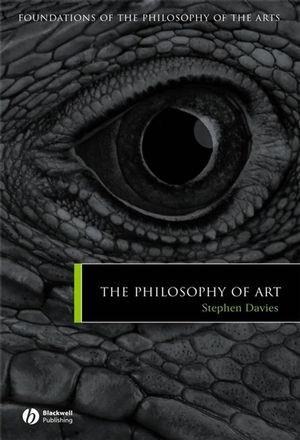|
Textbook
The Philosophy of ArtISBN: 978-1-4051-2022-7
Hardcover
252 pages
February 2006, ©2006, Wiley-Blackwell
 This is a Print-on-Demand title. It will be printed specifically to fill your order. Please allow an additional 15-20 days delivery time. The book is not returnable.
|
||||||
Preface.
Acknowledgments.
Why study the philosophy of art?.
Applications and questions.
References and readings.
Acknowledgements.
1. Evolution and culture.
A biological basis for art.
The cultural invention of art.
The big and the small picture.
"It all depends what you mean by the word art.".
Applications and Connections - the museum, tourist art, popular art, and ancient art.
Questions.
Further reading.
2. Defining art.
Essentialism and anti-essentialism.
Arguments against the project of definition.
If not an essence, what unifies the concept of art?.
Some definitions of art.
Definitions and non-Western art.
Taking stock.
Applications and Connections - intuition versus definition, art's value and definition, Euthyphro and experts.
Questions.
Further reading.
3. Aesthetics and the philosophy of art.
Aesthetic and artistic properties.
An illustration.
The aesthetic attitude and art for art's sake.
Aesthetic theory criticized.
Artworks that pose a challenge to aesthetic theory.
Art's contextually relative properties.
Art for art's sake, again.
Applications and Connections - copies and misattributions, viscera and understanding.
Questions.
Further reading.
4. Varieties of art.
Artworks as public items.
Are artworks created or discovered?.
Are all artworks potentially multiple?.
Multiply instanced artworks.
New works based on old ones.
The ontological variety of works of art.
Is the identity of an artwork fixed or evolving?.
Applications and Connections - musical recordings, the movie of the movie, the matter replicator.
Questions.
Further reading.
5. Interpretation.
When is interpretation necessary?.
What is interpreted?.
Actual intentionalism.
Hypothetical intentionalism.
Value maximization.
Uses for interpretation.
Theory-driven interpretation.
Does interpretation change the work's meaning?.
What is interpretation's primary purpose?.
Questions.
Further reading.
6. Expression and emotional responses.
The nature of emotion.
Identifying others' emotions.
Identifying the emotions in art.
The expression of emotion in music and abstract art.
The emotional response of the audience to the work of art.
Responding to fictions.
Responding to tragedies.
Responding to the expressiveness of instrumental music and abstract art.
Questions.
Further reading.
7. Pictorial representation and the visual arts.
The experience of representation.
Representation and resemblance.
Representation — culture and biology again.
Art versus non-art, a matter of style.
Representation in photographs and paintings.
Recognition and representation.
Photography as an art.
Moving images.
Questions.
Further reading.
8. The value of art.
Evaluation and functionality.
Rules, universality, and objectivity in artistic evaluation.
The purpose and form of artistic evaluation.
What is rewarding about the experience of art?.
Value and pleasure.
Art and education.
Messages through art.
The relation between artistic and moral values.
Should a work's immorality undermine its claims to artistic merit?.
Morality in documentaries and fictions.
Questions.
Further reading.
Index



